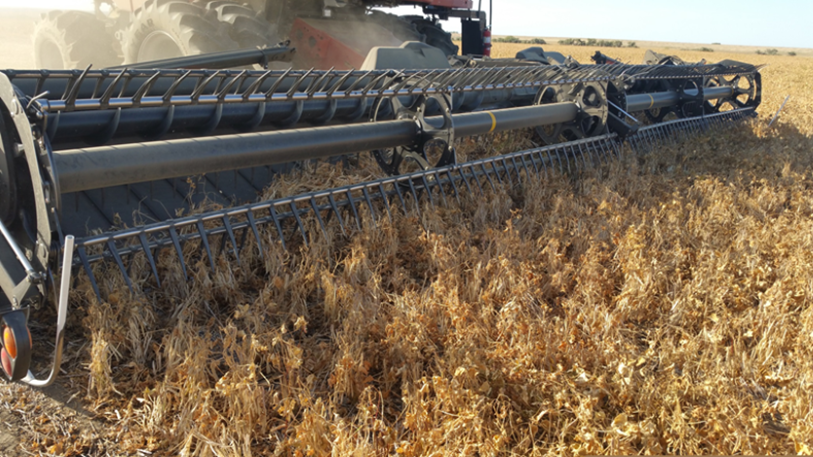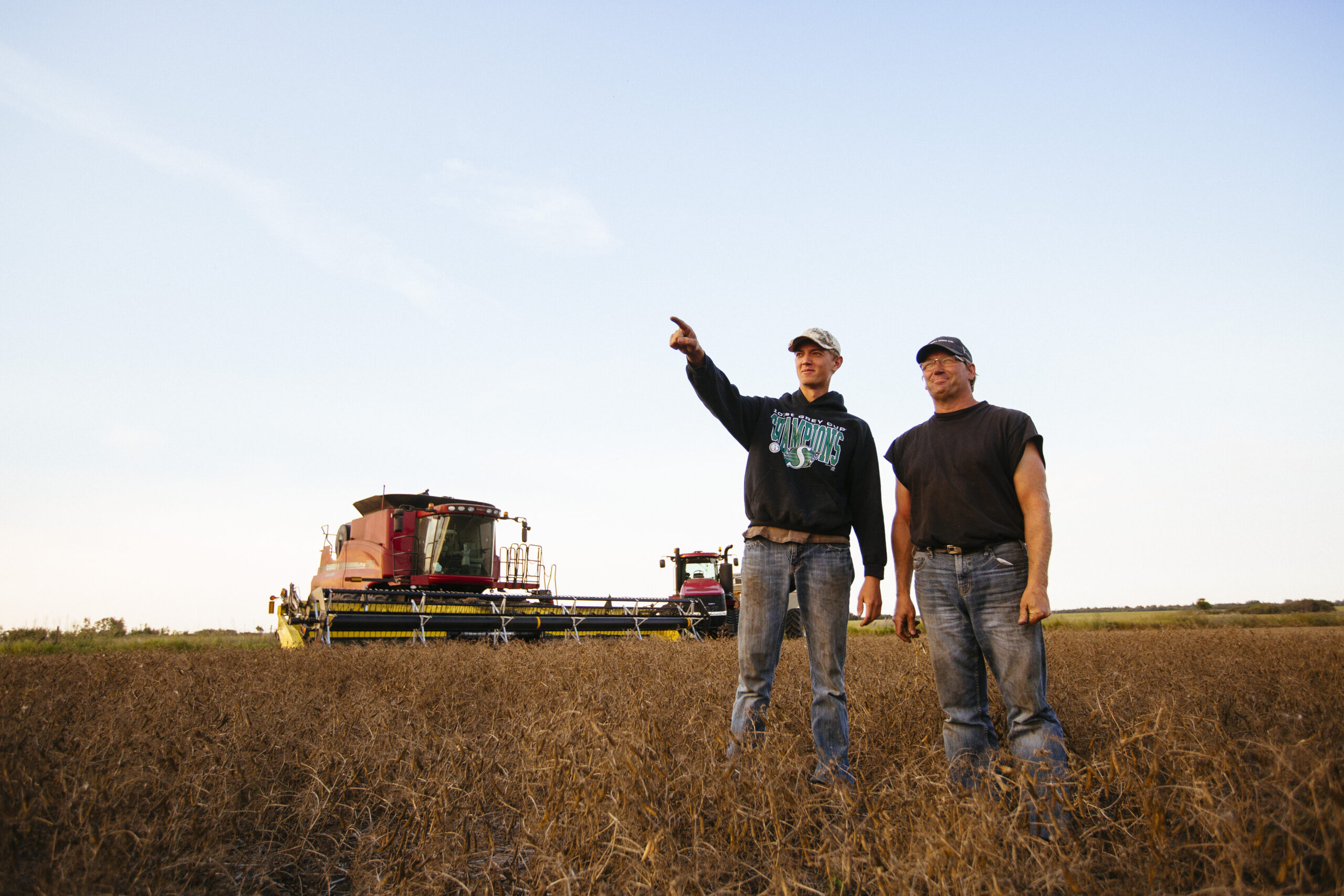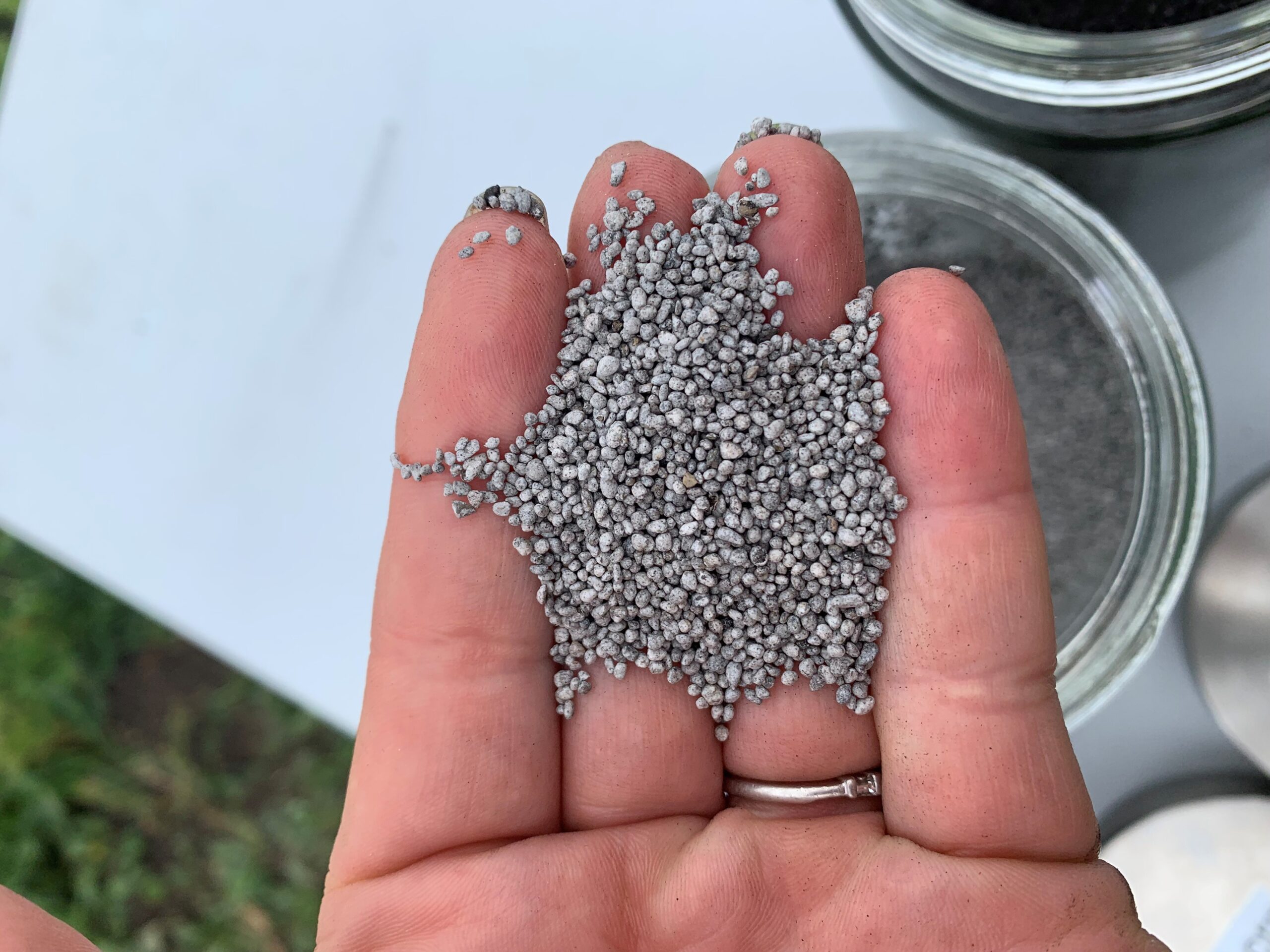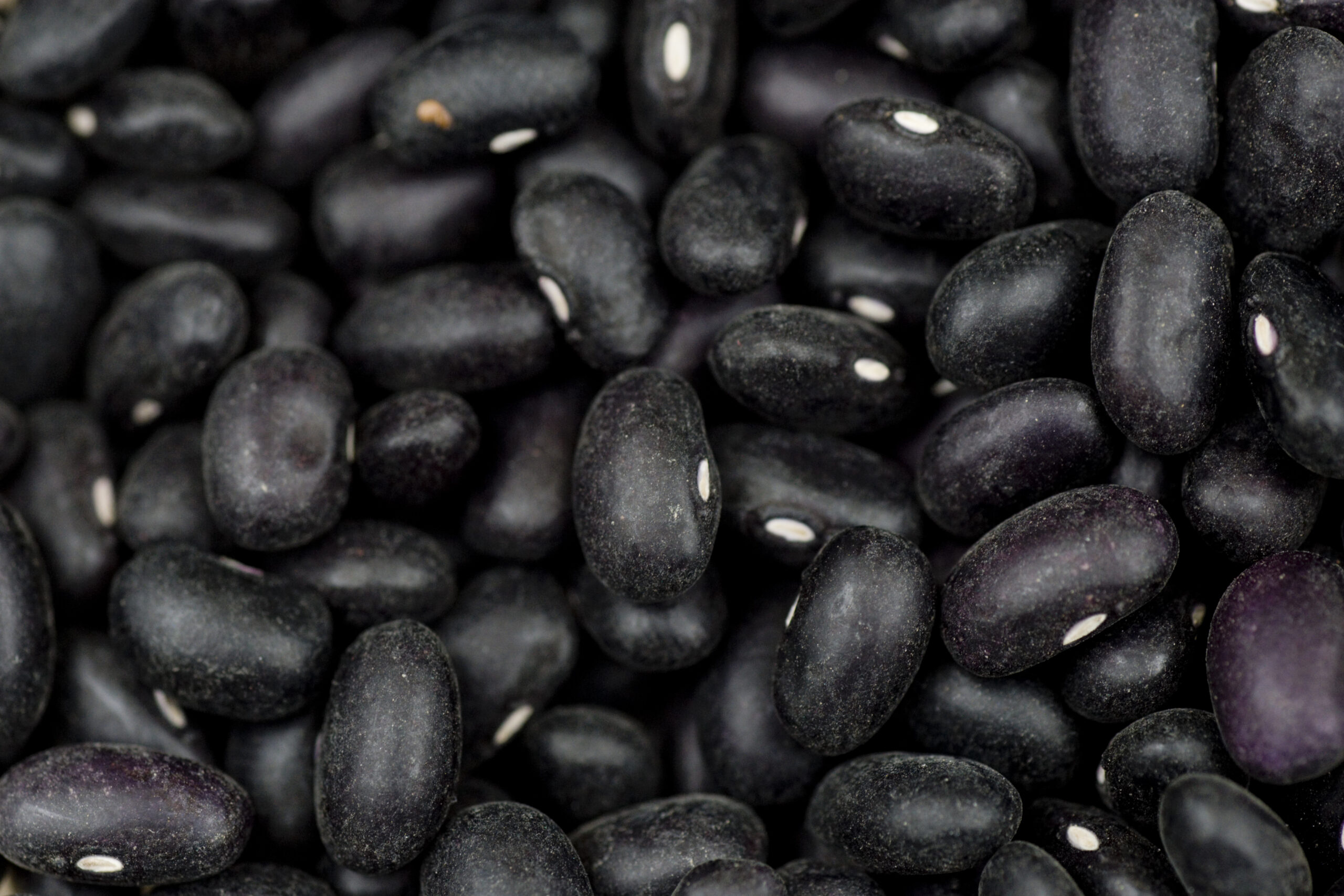By Bruce Barker, P.Ag.
Dryland, narrow-row, dry bean production that is being planted with conventional seeding equipment has established a foothold in Saskatchewan. Growers are seeing typical yields range from 1,000 to 1,500 pounds per acre.
Varieties
Narrow-row production should focus on varieties with upright plant structure such as Type I (determinate bush-type) and some Type II (indeterminate short vine) varieties that have higher pod set to facilitate easier harvest.
The Saskatchewan Variety of Grain Crops includes yield comparisons, maturity ratings, pod clearance, and growth type.
Pinto, navy, and black beans are the classes are the most conducive for narrow-row dry bean production. Varieties most suited include:
Table 1. Dry bean varieties suited to narrow-row production.
| Type | Early to Moderate Maturity | Later Maturity |
|---|---|---|
| Pinto | CDC Marmot (Type I) | Vibrant (Type II) |
| Navy | Portage (Type II) | AAC Shock (Type II) |
| Black | CDC Blackstrap (Type II) | CDC Super Jet (Type II) |

Source: Crop Development Centre
Later maturing varieties tend to be higher yielding and are suitable for areas with a longer growing season such as southeast Saskatchewan.
Field Selection
The Thin Black soil zone with a minimum of 1,800 heat units is best suited for dryland production. Saskatchewan Crop Insurance Corporation’s coverage map indicates areas where dry bean production can be insured.
Dry beans prefer medium textured loam soils. Adequate spring moisture and at least six to eight inches of timely rain, mostly during flowering and pod fill (July to August), is required for dryland production.
- Environmental Conditions
Dry beans do not tolerate salinity or excessively wet soils. They are very susceptible to ponding water and dry bean seedlings in standing water for 24 hours may be severely damaged. Beans are very sensitive to cold soils and can easily be damaged or killed by spring or early fall frost. - Crop Rotations
Dry beans are susceptible to white mould (sclerotinia). Sclerotia require four years to break down. Fields with a recent history of sclerotinia-susceptible crops such as potato, canola, sunflower, peas, faba beans, buckwheat, safflower, and dry beans should be avoided.
Do not grow dry beans on canola stubble due to high volunteer canola pressure and lack of control options.
Avoid seeding dry beans on soybean stubble as contamination of the dry bean seed sample with soybean seed can render the product unsaleable. To reduce contamination, seed and harvest dry beans prior to soybeans. - Herbicide Residues
Dry beans are very sensitive to herbicide residues and can be particularly sensitive to residue from clopyralid (LontrelTM, Pyralid), Muster®, Barricade® II, PredicadeTM, RetainTM, Signal® FSU, Traxos® Two, CurtailTM M, PrestigeTM XC, Pulsar®, and atrazine. Keep field records of herbicide use and consult Saskatchewan Ministry of Agriculture’s Guide to Crop Protection, and manufacturer labels for detailed information on recropping restrictions.

Seeding
Seeding Rate
Plant populations for narrow-row production on 9-12 inch row spacings should target 140,000 to 150,000 plants per acre for navy and black beans [50 to 60 pounds per acre (lb/ac)], and 80,000 to 90,000 plants per acre for pinto beans (70 to 80 lb/ac).
Account for up to 25 per cent seed damage when planting with an airseeder, and always calculate seeding rates using thousand kernel weight (TKW), as seed sizes between lots can vary (see Table 2). Emergence rates are based on germination rate minus an estimate of seed and seedling loss. For pulse crops, the emergence rates are typically 5-15 per cent less than the germination rate. Adjust emergence rates as needed based on seed lot germination and factors that could affect emergence of seedlings.
To reduce seed damage during seeding, air delivery systems should operate at low fan and air speeds. Some drills can be modified with seed deflection pads in manifolds to reduce cracking. Use conveyors when possible. Seed with moisture content of at least 14 per cent is less prone to cracking.
Seed Depth
Seed depth should be uniform at two to four centimetres (0.75 – 1.5 inches), but can be planted up to 2.5 inches deep to reach moisture. If planted too deep, plants struggle to emerge and are more prone to seedling diseases.
Seeding Date
Dry beans are typically seeded between May 25 and June 5 in Saskatchewan, but can vary by year depending on conditions in the spring, and can range from May 20 to June 7. Seeding earlier or later puts dry beans at risk of frost.
Soil Temperature
Ideally, soil temperatures should be at a minimum of 12°C for quick germination and growth. Cooler temperatures increase the risk of seedling diseases, and delay emergence.
Table 2. Estimates of target seeding rates based on TKW and 85 per cent emergence rates. Airseeder rates are 25 per cent higher than planter rate to adjust for increased seed damage.
| Class of Dry Bean | Thousand Kernel Weight (TKW) | Target Plant Populations | Target Seeding Rates (Based on 85% Emergence) | ||||
| Plants per Acre (ac) | Plants per Hectare (ha) | Planter Rate (kg/ha) | Planter Rate (kg/ha) | Planter Rate (kg/ha) | Planter Rate (kg/ha) | ||
| Black and Navy | 160 | 145,000 | 358,295 | 67.4 | 60.0 | 84.3 | 75.0 |
| 170 | 71.7 | 63.8 | 89.6 | 79.7 | |||
| 180 | 75.9 | 67.5 | 94.8 | 84.4 | |||
| 190 | 80.1 | 71.3 | 100.1 | 89.1 | |||
| 200 | 84.3 | 75.0 | 105.4 | 93.8 | |||
| Pinto | 300 | 85,000 | 210,035 | 74.1 | 66.0 | 92.7 | 82.5 |
| 320 | 79.1 | 70.4 | 98.8 | 88.0 | |||
| 340 | 84.0 | 74.8 | 105.0 | 93.5 | |||
| 360 | 89.0 | 79.2 | 111.2 | 99.0 | |||
| 380 | 93.9 | 83.6 | 117.4 | 104.5 | |||
Table 3. Expected plant populations adjusted by row spacing and dry bean class.
| Dry Bean Type | Thousand Kernel Weight (TKW) | Target Number of Plants Per Acre | Row Spacing (inches) | Target Plants per Square Foot | Expected Plants per Foot of Row |
|---|---|---|---|---|---|
| Black | 170 to 200 grams | 140,000 to 150,000 | 8 | 3.3 | 2.2 |
| Navy | 160 to 190 grams | (Average 145,000) | 9 | 2.5 | |
| 10 | 2.8 | ||||
| 12 | 3.3 | ||||
| 14 | 3.9 | ||||
| Pinto | 300 to 370 grams | 80,000 to 90,000 | 8 | 2.0 | 1.3 |
| (Average 85,000) | 9 | 1.5 | |||
| 10 | 1.6 | ||||
| 12 | 2.0 | ||||
| 14 | 2.3 |
Rolling
Reduce the risk of rock damage to harvesting equipment and reduce earthtag on beans by rolling them after seeding and prior to emergence. Roll up to three days after germination, to avoid damaging the growing stems. Do not roll during or after plant emergence, as plants are very susceptible to damage.

Source: Jeff Ewen
Inoculation
Dry beans are not as efficient at fixing nitrogen compared to other pulses. Experienced growers combine inoculation with nitrogen fertilizer application.
Dry bean inoculants contain the bacteria Rhizobium phaseoli. Granular, dry, and liquid inoculants have been available at times, but formulation availability has not always been assured. Growers should enquire about dry bean inoculants early in their planning stages. When choosing an inoculant, check the compatibility with any seed treatments. Using granular inoculant applied in-row with the seed will help to avoid compatibility issues.
Inhibition of nodule formation and activity occurs as soil nitrate-nitrogen levels rise above 39 kilograms per hectare (35 lb/ac), and little fixation occurs with soil nitrate-nitrogen levels exceeding 60 kg/ha (55 lb/ac).
Fertility
Soil sample to determine background fertility. Dry beans are very sensitive to seed-placed fertilizer and most fertilizer should placed away from the seed.
Table 4. Dry Bean Nutrient Uptake and Removal (Pounds per Hundredweight)
| Nitrogen | Phosphorus | Potassium | Sulphur | |
|---|---|---|---|---|
| Uptake | 4.67 | 1.39 | 3.95 | 0.34 |
| Removal | 3.50 | 1.12 | 1.88 | 0.22 |
Source: Heard et al. 2006
Nitrogen
The current recommendation for non-irrigated dry bean production in Saskatchewan is to inoculate the seed and apply 55 kg/ha or 50 lb/ac starter nitrogen.
Phosphorus
If soil test phosphorus levels are low (less than 28 kg/ha or 25 lb/ac) then the recommendation is to apply 30-35 lb/ac of phosphate (P205) with dryland solid-seeded dry beans. However, the safe rate of seeded placed phosphorus is 17 kg P205/ha (15 lb/ac) with 15 -17 centimetre (cm) or 6-7 inch rows in good moisture.
Potassium
Most soils in Saskatchewan have high levels of available potassium, but levels may be low on sandy soils. If potassium fertilizer is recommended, side-band it away from the seed. Current recommendation for solid seeded dry beans is 20 lb/ac of actual potassium when soil tests are low.
Sulphur
Since sulphur is often highly variable across a field, growers may choose to apply some sulphur to ensure that areas are not deficient, even though composite soil tests may show adequate levels. If a soil test indicates sulphur deficiencies, plant-available forms of sulphate fertilizer can be side-banded or mid-row banded.
Micronutrients
Micronutrient deficiencies are not widespread across Saskatchewan. However, zinc deficiencies can occur in dry bean, although research in Saskatchewan has not yet identified widespread zinc deficiency problems. Navy bean tends to be more susceptible to a zinc deficiency than coloured bean, and recent research indicates that zinc deficiency may be variety specific.
To correct zinc deficiencies prior to seeding, the Saskatchewan Ministry of Agriculture recommends banding 2-5 lb of actual zinc per acre in the sulphate form. For in-crop foliar application, apply 0.3 lb actual zinc per acre in the chelated form. Severely zinc deficient bean crops may require two foliar applications to correct the deficiency.
Alberta recommendations on irrigated medium-to-fine textured soils indicate that zinc is not recommended above a critical level of 1.5 parts per million (ppm) from a soil analysis of a 0-6 inch (0-15 cm) soil sample depth using the diethylenetriaminepentaacetic acid (DTPA) extractable zinc method.
- between 1 and 1.5 ppm, 3 lb of soil applied zinc per acre is recommended
- below 1 ppm, 5 lb of soil applied zinc per acre is recommended
In Manitoba, the deficient soil test level has been established at less than 0.5 ppm for field beans.
Weeds
For herbicide application recommendations, precautions and detailed weed control recommendations, consult product labels and the Saskatchewan Ministry of Agriculture’s Guide to Crop Protection for registered applications.
Dry beans are not competitive and severe yield losses will occur even when there is low weed pressure. Control perennial weeds such as Canada thistle, perennial sow thistle, dandelions, and quackgrass in the years preceding dry bean production.
Research in Minnesota found that the critical weed-free period was 20-42 days after planting, indicating that weed control should begin no later than 20 days after planting and continue until 42 days after planting. Consider layering herbicides using pre-seed or pre-emergence products, as well as in-crop herbicides. Experienced bean growers have found that a second application of a post-emergent broadleaf weed herbicide is often required for improved yields, and to reduce harvest problems with weeds.
There are a number of herbicides registered for use with dry beans but not all products are registered for all classes. Always check labels to ensure the product is registered and safe for use on the dry bean class of choice.
Pre-seed herbicides: Dual II Magnum®, Edge® Granular, Eptam® Liquide EC, Frontier® Max, Permit®, and trifluralin.
Pre-emergent burn-off herbicides: Aim®, CleanStart®, tribenuron, and glyphosate.
Post-emergent herbicides: bentazon, clethodim, imazethapyr, GoldWing®, Permit®, Poast® Ultra, quizalofop, and Viper® ADV.
Disease
Seed and Seedling Diseases
Dry beans are susceptible to root rot disease complex that can include Fusarium, Rhizoctonia, and/or Pythium. Dry beans are not resistant to the Aphanomyces euteiches root pathogen and have been shown to have variable responses. They can be a host of the pathogen but may only produce a few oospores.
Use good quality seed to encourage vigorous growth. A number of seed treatment fungicides are registered on dry beans for the control of seed rot, root rot, and seedling diseases. Some products are available to commercial seed treaters only.

Source: Jeff Ewen
White Mould
White mould (Sclerotinia sclerotiorum) is a major foliar disease of dry beans and can cause severe crop loss. White mould is almost always present on irrigated dry beans. Narrow-row production can also increase the risk of white mould due to limited air movement under the crop canopy.
To reduce the risk of white mould, avoid crop rotations with a history of susceptible broadleaf crops within the three previous years, and avoid planting bean crops adjacent to fields infected with the disease in the previous year.
Growers should budget a foliar fungicide application for control of white mould.
Bacterial Blight
Blights are most prevalent in wet, windy weather and can be spread by rain splash. In Saskatchewan the two most common blights that affect dry beans include common bacterial blight (Xanthomonas campestris pu. Phaseoli) and halo blight (Pseudomonas syringae pv. Phaseolicola).

Source: Kirstin Bett, University of Saskatchewan
Common bacterial blight is characterized by large, irregularly shaped lesions surrounded by a chlorotic halo. Veins near the lesions are darkened and pods will develop a greasy looking spot also surrounded by a chlorotic halo that will ooze yellow when wet. Resistance to common bacteria blight can be variety specific and is a goal of most dry bean breeding programs.
Less prevalent is halo blight that starts as small, water soaked spots that die leaving chocolate brown lesions with a light green halo around them, and pod lesions will ooze a white/cream colour when wet. Pinto, great northern, and red Mexican bean varieties have some tolerance to halo blight.
Both blights are seed-borne and soil residue borne, so using disease free seed is very important. Longer rotation will help lessen pathogen load as well.
Copper fungicides can help control blights in-season, but are ineffective when wet weather favours the development of the disease.
Viral Diseases
Dry bean seedlings can suffer from bean common mosaic virus or yellow mosaic virus. The symptoms include stunted and spindly plants, producing few pods and small, off-colour seeds. Leaves appear puckered and twisted.
The viruses are spread by insects such as aphids, and can also be spread by planting infected seed. Plant breeders have developed varieties that are resistant to a number of strains of viruses. Growers should use virus-free seed to prevent the diseases.
Rust (Uromyces appendiculatus) and Anthracnose (Colletotrichum lindemuthianum) are generally not a concern in Saskatchewan on dry beans. The pathogen causing Anthracnose in dry beans is specific to dry beans and does not affect other pulse crops.
Insects
The most common insects that cause damage in dry bean are cutworms and wireworms. Other occasional pests include pea aphid, alfalfa looper, grasshoppers, lygus bug, potato leaf hopper, and seed corn maggot. However, very few economic thresholds have been established for foliar control. Consult the Saskatchewan Guide to Crop Protection for registered insecticide seed treatments and foliar insecticides.
Cutworm
Cutworms can feed on dry beans and cut-off the plant below the soil surface. Dry beans do not have growing points below-ground, therefore they cannot regrow after being cut off. Crops should be scouted regularly in early spring, and if dead wilted plants are observed, the soil around and up the row from the plant should be examined for the presence of cutworms.
Wireworm
Seed treatments are available to control wireworms. Feeding damage results in wilted plants, but unlike cutworm, the seedling generally remains attached to the root.
Harvest

Source: Jeff Ewen
Quality is very important, and seedcoat colour and viability must be high for the edible market. Both earth-tag (soil stains on seeds) or stains from green leaves or immature weedy material are undesirable for marketing. Harvest management can be facilitated by managing weeds with pre-harvest glyphosate, speeding drydown with desiccation, and/or swathing.
Pre-Harvest Glyphosate
Glyphosate is registered as a pre-harvest herbicide for weed control. It is not a desiccant. Not all glyphosate products are registered for pre-harvest application. Consult Keep It Clean! and your grain buyers prior to use, as there may be some market access concerns with glyphosate residues. It is important to know the target market by consulting buyers prior to pre-harvest glyphosate applications.
Pre-harvest glyphosate guidelines:
- Controls Canada thistle, perennial sow thistle, quackgrass, common milkweed, toadflax, and dandelion
- Apply when grain moisture is less than 30 per cent at 75 per cent buckskin stage
- Stems are green to brown in colour, pods are mature (yellow in colour), 80 to 90 per cent leaf drop of original leaves
- Wait three full days (72 hours) after application before swathing to allow thorough translocation for long-term weed control
- The crop may be harvested (straight-cut or swath pickup) 7-14 days after application. This is the pre-harvest interval
Desiccation
Desiccation can help dry down the crop to facilitate harvest. Ensure that the product you choose is approved and that labeled rates and pre-harvest intervals are followed to protect access to pulse export markets. Application of desiccants should occur when the crop is at physiological maturity, which is less than 30 per cent moisture content of the seed. This stage occurs when the pods are at 75 per cent buckskin stage, which is when 80-90 per cent of the crop has lost its leaves.
Table 5. Desiccant Herbicides for Use in Dry Bean
| Herbicide Group | Herbicide | Pre-Harvest Interval |
|---|---|---|
| 14 | Aim® (carfentrazone) | 3 days |
| 9+14 | CleanStart® (cafentrazone + glyphosate) | 3 days |
| 22 | Reglone®/Reglone® Ion/Desica™/Armory™ 240/Diquat 240/Bolster®/ Stage™/DriFast™/Guardsman® Diquat/Craven™ (Diquat) | 4-10 days |
| 14 | Heat® LG/WG (saflufenacil) | 3 days |
| 14 | Valtera™ (flumioxazin) | 5 days |
Source: Guide to Crop Protection, Saskatchewan 2018
Always refer to Keep It Clean! and your grain buyer prior to use to ensure market access. This chart is intended as a guide only. Consult product label prior to use for final detailed instructions. Pre-harvest interval is the time to wait between herbicide application and seed harvest.
Swathing
Beans grown in solid-seeded systems are often swathed prior to combining. Swathing occurs when 75 per cent of the pods are in the buckskin stage and at less than 30 per cent moisture. At this stage the beans have turned yellow but the pods are still flexible. Most of the leaves will have dropped off the plant at this stage. Swathing after a dew can help reduce losses if maturity is variable and some pods are at more risk of shattering.
Vine lifters and pickup reels can help reduce losses. Swaths are susceptible to wind damage and rotting if swaths become wet from rain.

Source: Jeff Ewen
Straight-Cutting
Dry beans may also be straight-cut when 75 per cent of the pods are dry and the remaining pods are in the buckskin stage. Use of vine lifters or flex headers can be helpful. Straight combining works best if the crop is uniform and free of green, weedy material.
Moisture Content
To minimize seed damage during threshing, dry beans should be combined when the seed is at moisture content of 18-22 per cent. Dry beans are considered dry at 12-16 per cent seed moisture. If moisture drops too low cracking becomes an issue. Waiting until moisture increases in the evening or early morning may be necessary.
Combine Settings
Combines set improperly, or harvesting at low moisture can result in excessive cracking and breaking of seed. Combining dry beans can be done with either special bean combines or rotary/conventional combines.
In general, rotary combines are gentler on beans than conventional combines, especially if the rotor is kept full to help cushion the beans.
Cylinder speed should be set up between 150-400 revolutions per minute, slowing the speed down as the beans dry. Initial concave settings should be ½ inch front, ¼ inch rear. Increase settings as beans get drier. Set chaffer at ⅝ inch and sieve at 7/16 inch. The wind speed should be high to remove as much of the pods as possible.
Storage and Handling
Handle dry beans as little as possible once harvested, and as gently as possible to avoid cracking the seed. Conveyors and bean ladders should be used when possible to assist in filling bins to help reduce damage. Smaller bins should be considered to limit the height of seed drop and minimize damage.
Dry beans are often traded at 17 per cent moisture but are considered dry at 16 per cent moisture. Discounts for beans below 15 per cent moisture may be applied.
Aeration fans can be used to reduce moisture of beans harvested at 18-22 per cent moisture, but care should be taken to avoid over drying. If storing and hauling at later dates, care should be taken not to handle beans at very cold temperatures (less than -20°C), as the risk of cracking will increase.


